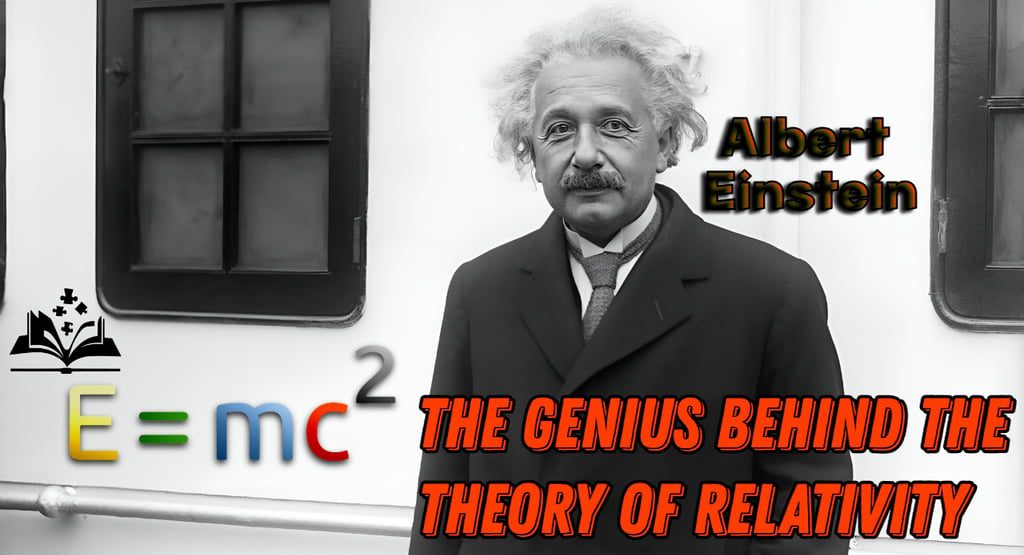
Albert Einstein: The Genius Behind the Theory of Relativity
Uncover the life and legacy of Albert Einstein, the visionary physicist whose theories reshaped our understanding of the universe. Learn about his scientific breakthroughs, personal journey, and lasting impact on humanity.
GREAT SCIENTISTSCIENCE/PHILOSOPHYBIOGRAPHYEDUCATION/KNOWLEDGE
Sachin K Chaurasiya
12/28/20245 min read


Albert Einstein, one of the most iconic figures in science, reshaped our understanding of the universe with his groundbreaking theories. Known as the father of modern physics, Einstein’s contributions transcended the realm of science and became a symbol of intellectual brilliance, curiosity, and human resilience. This article delves into his life, work, and enduring legacy.
Early Life and Education
Born on March 14, 1879, in Ulm, Germany, Albert Einstein displayed curiosity about the natural world from a young age. Contrary to the myth that he was a poor student, Einstein excelled in mathematics and physics. However, his rebellious spirit clashed with the rigid schooling system of the time. His early fascination with a compass given to him by his father is often cited as the spark that ignited his passion for science.
Einstein later attended the Polytechnic Institute in Zurich, Switzerland, where he struggled initially but eventually earned his teaching diploma in 1900. During these years, his fascination with light, space, and time began to take shape. Despite graduating, Einstein faced difficulty securing a teaching position and took a job as a clerk at the Swiss Patent Office in Bern. This period of his life provided the intellectual freedom to develop some of his most revolutionary ideas.
The Miracle Year: 1905
Einstein's "Annus Mirabilis" (Miracle Year) in 1905 marked a turning point in the history of science. While working as a patent clerk, he published four groundbreaking papers that laid the foundation for modern physics:
Photoelectric Effect: Demonstrating that light behaves as both particles and waves, this work earned him the Nobel Prize in Physics in 1921 and established quantum theory.
Special Theory of Relativity: Introducing the revolutionary concept that time and space are relative, not absolute, this theory culminated in the famous equation linking mass and energy.
Brownian Motion: Providing empirical evidence for the existence of atoms, this work bridged the gap between theoretical physics and empirical observation.
Mass-Energy Equivalence: A concept that would later influence advancements in nuclear energy and cosmology.
These papers not only redefined physics but also showcased Einstein’s ability to think beyond conventional boundaries.
General Theory of Relativity & Global Recognition!
In 1915, Einstein presented his General Theory of Relativity, a monumental leap in understanding gravity. Unlike Newton’s notion of gravity as a force, Einstein proposed that massive objects warp the fabric of spacetime, creating the effect we perceive as gravity. This theory was confirmed in 1919 during a solar eclipse, catapulting Einstein to international fame.
His relativity theories provided the framework for understanding black holes, gravitational waves, and the expansion of the universe. Over a century later, these concepts remain pillars of astrophysics.
Einstein’s fame extended beyond the scientific community. He became a global figure, admired not only for his intellect but also for his humble demeanor and wit. His distinctive appearance, with his wild hair and kind eyes, turned him into a cultural icon.
A Humanitarian Scientist
Einstein’s intellectual pursuits were deeply intertwined with his moral convictions. A pacifist and advocate for global peace, he opposed World War I and later the rise of Nazism in Germany. Being Jewish, Einstein emigrated to the United States in 1933 to escape persecution, joining Princeton University’s Institute for Advanced Study.
During World War II, Einstein urged President Franklin D. Roosevelt to consider the potential development of atomic weapons by Nazi Germany, leading to the Manhattan Project. However, he later lamented the destructive use of atomic bombs and became a vocal proponent of nuclear disarmament.
Einstein also championed civil rights, supporting efforts against racial discrimination in the United States. He was a member of the NAACP and worked alongside figures like W.E.B. Du Bois. His humanitarianism reflected a belief that science should serve humanity.


Personal Life & Philosophical Insights!
Einstein’s personal life was as complex as his theories. He married twice, first to Mileva Marić, with whom he had three children, and later to his cousin Elsa Löwenthal. Despite his fame, he remained a private person, often retreating into his thoughts.
He was also a philosopher, often pondering the nature of existence, free will, and the universe. His famous quip, “God does not play dice with the universe,” reflected his discomfort with the probabilistic nature of quantum mechanics. Einstein saw science as a means to uncover the harmonious laws underlying reality.
Later Years and Contributions Beyond Science!
In his later years, Einstein continued to contribute to theoretical physics, exploring concepts like unified field theory, an attempt to reconcile quantum mechanics and general relativity. Although he did not succeed in this endeavor, his efforts inspired future generations of physicists.
Einstein was also an educator and mentor, passionately advocating for curiosity-driven learning. His letters and speeches often emphasized the importance of imagination and critical thinking. One of his most quoted lines, “Education is not the learning of facts, but the training of the mind to think,” encapsulates his philosophy.
He maintained a deep connection to music throughout his life, often playing the violin as a way to relax and reflect. He believed that music and science were interconnected, once remarking, “If I were not a physicist, I would probably be a musician.”
Legacy and Impact!
Albert Einstein passed away on April 18, 1955, in Princeton, New Jersey. Even in death, his contributions continue to resonate across science, philosophy, and culture. His theories laid the groundwork for technologies such as GPS, lasers, and nuclear energy. Beyond his scientific achievements, Einstein remains an enduring symbol of intellectual curiosity and moral courage.
Einstein’s brain, famously preserved for scientific study, revealed an unusually high density of neurons in regions associated with analytical thinking. While such studies have sparked controversy, they underscore the fascination with Einstein’s extraordinary mind.
Einstein’s correspondence and published works continue to inspire students, scientists, and thinkers worldwide. His archives, including thousands of letters and manuscripts, are preserved and studied to this day, offering insight into his genius and humanity.
Inspiring the Future
Albert Einstein’s life is a testament to the power of curiosity and imagination. His ability to question the fundamental assumptions of his time not only transformed science but also inspired generations to explore the unknown. As he once said, “Imagination is more important than knowledge. For knowledge is limited, whereas imagination embraces the entire world.”


In celebrating Einstein, we honor not just his brilliance but also his enduring message: the pursuit of knowledge and truth is the highest aspiration of humanity. His legacy reminds us that the greatest discoveries often begin with the simplest questions: Why? How? What if?
As humanity continues to unravel the mysteries of the cosmos, Einstein’s work serves as both a foundation and a beacon, guiding us toward new horizons of understanding and innovation.
Subscribe To Our Newsletter
All © Copyright reserved by Accessible-Learning Hub
| Terms & Conditions
Knowledge is power. Learn with Us. 📚


